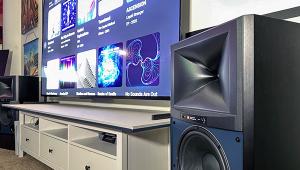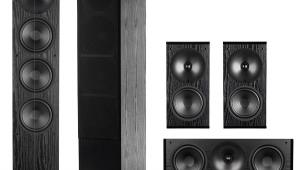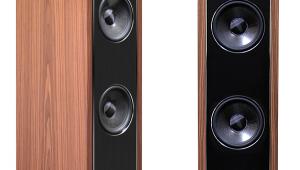Atlantic Technology System 6200 surround speaker system Page 2
The System 6200 arrived in a veritable truckload of boxes. After they've been unpacked, some assembly is required. You have to install the trim panels on all cabinets (except the surrounds), and the feet on the subwoofer pedestals. It isn't all that difficult, but it does require some care to properly engage the clips that hold the panels in place, in order to avoid putting them on upside down or damaging the finish in an attempt to pound them into place. Some of the panels were tight fits—use a hard rubber mallet, not a hammer. Better yet, get your dealer to set up the system for you!
I set up all the speakers in my usual locations: the front left and right flanking the projection screen, the center just below and aimed up toward the listening position (a tilting base supplied with the center-channel simplifies this step), the surrounds above ear-level on the left and right walls to the sides of the listening position. The manual recommends positioning the subs with their drivers facing inward, but the opposite arrangement seemed more suitable for my system, in which the speakers are close to the screen, and there is plenty of room on the outside of the speakers.
 I was fortunate to have a Sencore Audio Analyzer on hand. It provided up to 1/12-octave resolution, so I used it to adjust the sub's parametric equalizer for flattest response at the main listening position. When I was done, the response—measured and audible—had im- proved dramatically. Keep in mind, however, that without time and position averaging of some sort—an exercise difficult for any owner or installer equipped with affordable test tools—improvements as measured at the main listening chair (the "Money Seat") will rarely result in as good a response, or as much improvement, in other seats. Indeed, in some cases, one of the seats (the "Mother-in-Law Chair"), or more, might actually measure worse.
I was fortunate to have a Sencore Audio Analyzer on hand. It provided up to 1/12-octave resolution, so I used it to adjust the sub's parametric equalizer for flattest response at the main listening position. When I was done, the response—measured and audible—had im- proved dramatically. Keep in mind, however, that without time and position averaging of some sort—an exercise difficult for any owner or installer equipped with affordable test tools—improvements as measured at the main listening chair (the "Money Seat") will rarely result in as good a response, or as much improvement, in other seats. Indeed, in some cases, one of the seats (the "Mother-in-Law Chair"), or more, might actually measure worse.
There's only one way to drive the System 6200 PedWoofers: with a direct connection from the mono subwoofer output of your pre-pro or receiver into the SA-6200 equalizer-amp. That makes the SA-6200's lowpass crossover control a little superfluous; you're usually better off using the lowpass filter in your pre-pro and setting the lowpass control on the SA-6200 to THX/EXT (bypass). With a receiver, it might be worth experimenting with the lowpass settings on the SA-6200. The filters in receivers (particularly lower-priced models) are not always as steep as they should be; a gradual slope on the woofer can muddy the mid- and upper bass.
I had three issues with the design of the SA-6200 amplifier, the first being avoidable with proper setup. It appears that the SA-6200 amplifier is quite sensitive to ground loops. I hadn't previously experienced any in my system, at least none that were audible. But when I switched the SA-6200's lowpass filter control to EXT or Off, a buzz appeared—low in level, but audible at a distance of 4 feet from the subs. The cure was simple. For some reason, the subwoofer output level from my pre-pro was set at a very low level, with the SA-6200's level control set to about 1 o'clock. Turning the latter down to 9:30 completely eliminated the buzz, even when my ear was up against the driver in one of the subs. But to rebalance the system, I had to dramatically increase the gain on the surround processor—by 18dB!
That brings up a related concern. Assuming the SA-6200 is as sensitive to hum pickup in your system as it was in mine (that won't always be the case), your pre-pro or receiver must have enough gain in its subwoofer output to avoid this problem. Most should, but we can't guarantee that all will, particularly lower-priced receivers. Of course, it's unlikely that many such receivers will be used with a speaker in this price range.
The second issue involved the subwoofer remote. The SA-6200 amp didn't just respond to its own remote, but to the remotes of two other products I used with it: the Parasound and TAG McLaren pre-pros. I first noticed this when I was experimenting with overall playback levels, and discovered after a time that the subwoofer level had increased by 8dB!
Finally, an ergonomic concern: The controls for the parametric equalizer turn very easily, and because they're analog, there's no way to "lock" them or note their correct settings (except very roughly). You won't want to repeat the calibration process every time Junior decides he wants to hear more bass from his latest MP3-loaded CD, so it would be nice to have a screwed-down cover of metal or Plexiglas to keep prying fingers away from the controls.
Music On Tap
Rather than bowling me over immediately, the sound of the System 6200 snuck up on me—usually, the mark of a good speaker. Its top end was sweet yet clearly detailed, its midrange free of obvious colorations, and its bass—after setup and calibration—full-bodied and free of boom or bloat. For 2-channel stereo tests, I pulled out all of my usual test CDs—male vocals from Mighty Sam McClain to (time-warp alert) Gordon Lightfoot, female vocals from Holly Cole to Jennifer Warnes, vocal-instrumental groups from the Chieftains to Clannad, and many stops in between, including a fair helping of classical. The System 6200 never disappointed.
I did find that, in 2-channel mode, the midrange, while uncolored, sounded subtly veiled compared to the best speakers I've auditioned. The top end, while clean and detailed, was just a little lacking in air and openness. Neither of these was a serious flaw, but I tried three solutions, all of which together largely solved both problems. First, I removed the perforated metal grilles. Voilà—a small but worthwhile increase in transparency. Then I set the HF Energy controls to Damped Room (my room, while not dead, is on the soft side of neutral).
Finally, I noticed that the tweeters on the left- and right-channel speakers were 4 inches above my seated ear height of 41.5 inches (as designed, the tweeters will be above the seated ear height of most listeners). I tilted the 6200 LRs (not the subwoofers under them) forward slightly. More detail—and enough. The sound retained all of its positive traits, but now the midrange was free of that slight veiling and the highs were clean and airy—and retained a degree of forgiveness of less-than-ideal sources while still providing all the detail I could want.
























































